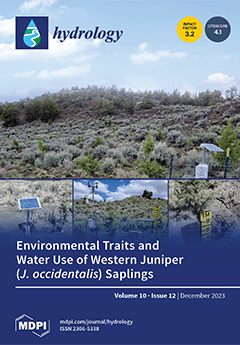The present study investigated the performance of three different stilling basins, i.e., modified United State Bureau of Reclamation (USBR)
Type III, USBR
Type II, and wedge-shaped baffle blocks (
WSBB), using FLOW-3D scour models. Field data of the riverbed profile
[...] Read more.
The present study investigated the performance of three different stilling basins, i.e., modified United State Bureau of Reclamation (USBR)
Type III, USBR
Type II, and wedge-shaped baffle blocks (
WSBB), using FLOW-3D scour models. Field data of the riverbed profile are employed to validate the present models. After comparison, the results of statistical indices, i.e., coefficient of determination (
R2) and Nash–Sutcliffe model efficiency coefficient (
NSE), indicated that the Renormalization Group (RNG-K-ϵ) showed good agreement with the field data, with R2 and NSE values of 0.9094 and 0.896, respectively. Validated models are used to simulate velocity field and local bed shear stress (
BSS) and scour for design and flood discharges of 28.30 m
3/s/m and 17.5 m
3/s/m, respectively. At 28.30 m
3/s/m, the results indicated that the riverbed downstream of the remodeled basin was completely exposed, while, at 17.5 m
3/s/m, the net change in bed reached 85%. At 28.30 m
3/s/m, the net change at the centerline of models reached 51% and 67% in USBR
Type III and
WSBB basins, respectively. At 17.5 m
3/s/m, compared to
Type II and
III basins, the
WSBB basin indicated less
BSS, which significantly reduced the scour. Conclusively, the
Type II basin showed less energy dissipation for the studied flows, while the
WSBB basin improved flow fields downstream of the barrage.
Full article





